
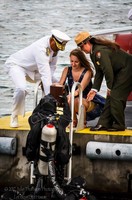



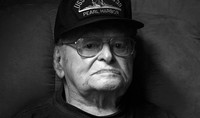
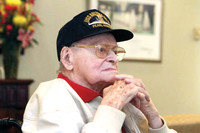
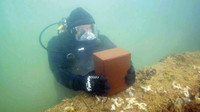
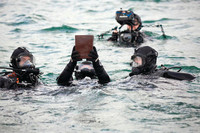
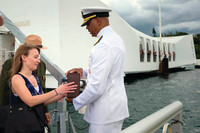

The World War II Foundation has completed its 19th film about the men and women who served in that war, Journey Home to the USS Arizona. It premiered at the Jane Pickens Theatre in Newport on November 4. Film and stage actor Matthew Broderick narrates the hour-long documentary.
According to his family, Ray Haerry Sr. didn’t often speak of the USS Arizona or about Pearl Harbor and they pretty much knew why. 1,177 of the battleship’s crew died in the sneak attack on Pearl Harbor on December 7, 1941. Ray was lucky.
He was blown clear of the ship before the bomb that hit the forward ammunition magazine doomed the ship and much of the crew. He was swimming toward Ford’s Island through flaming oil while most of his mates perished in the explosion and fire that followed. Though injured and exhausted when he reached the island, Haerry picked up a rifle and fired back at the diving bombers, feeling frustrated and angry when the bullets did nothing to stop the attackers.
After the Japanese planes retreated into the Pacific sky, there was more frustration and anger as rescuers tried to cut through the hulk of the ship to save the crewmen trapped below deck by the. They worked as fast as they could, letting the metallic raps from within guide their efforts until the rapping stopped and they knew they would never reach the sailors in time. Only 335 of the sailors survived, each of them left with memories they’d rather not have.
“We interviewed him when we were working on another film and he told us he never wanted to visit the Arizona or even talk about it much,” said South Kingstown filmmaker Tim Gray. “Then, as he approached the last days of his life, he began to talk about and then expressed a desire to be buried in the Arizona Memorial. This film, The Journey Home to the USS Arizona, is about the process of doing that.”
Gray said this is not another look at the images of Pearl Harbor that have become so familiar. It’s more a chronicle of reconciliation, of the changes that happened to survivors as the horrors of Pearl Harbor receded into veterans’ memories and were replaced with a desire to be laid to rest with their crew-mates. Haerry is the 42nd of the survivors to be returned to the Arizona since 1982, when the Navy first allowed the interment of the Arizona veterans. Gray said the Navy is very strict about who is allowed.
“You have to have been a member of the crew on the day of the attack, and you actually had to be on board at the time, not ashore sleeping one off after a few too many from the night before,” said Gray. “The Navy also gave us access to the process that was never granted before.” Gray said the film is less about the raid itself and more about the process of interment and the abiding respect that Americans still have for those who have served in the military.
“It’s not a story about war, but emphasizes that America still believes in recognizing and honoring its heroes, especially those who were there in the opening moments of America’s involvement in World War II.” Gray said the film follows Haerry’s family as they start their journey from Rhode Island and through New Jersey, to Dallas, to Honolulu.
As word of their mission spread, the welcoming grew more elaborate. “There were bagpipes in New Jersey and a water cannon salute from the Port Authority. People were waiting for us. As word got out, people started to plan for us all the way through to Pearl Harbor, where the Commander of Pearl Harbor met us.”
Ray Haerry stayed in the Navy for the rest of World War II and Korea and taught at the Officer Training School in Newport until he retired. He took most of his Pearl Harbor memories with him. It was only after his own mortality reminded him that days like December 7, 1941 may slip from our national memory if we fail to remind subsequent generations of just how much it cost to preserve what we all take too much for granted. His children agreed and made good on their promise to take him home. “Only five survivors are left,” said Gray. “Of them, two have expressed a wish to go back. The others have not yet decided.”
The Rhode Island based foundation is dedicated to preserving the stories of the 16 million veterans of World War II. It has produced films about the battles, the people and the horrors of the Nazi occupation of Europe. The films have largely been seen on PBS stations nationally and have earned the foundation, and Gray himself, a number of awards. After the premier in Rhode Island The film will head to American Public Television where it will air nationally on over 115 PBS stations in the United States. Check your local listing for dates and times. It makes a Hawaiian premiere on Ford Island at Pearl Harbor on December 3rd.
76 years after he survived the attack on Pearl Harbor, Ray Haerry joined his fellow sailors in eternal rest. His granddaughter Jessica Marino and her family attended his interment ceremony at Pearl Harbor on April 15, 2017.
Comments
No comments on this item Please log in to comment by clicking here